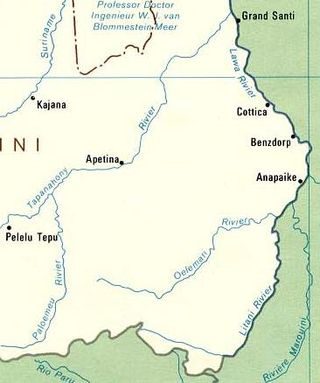"God zij met ons Suriname", or "Opo kondreman", is the national anthem of Suriname. It has two verses: the first in Dutch and the second in Sranan Tongo.

Commewijne is a district of Suriname, located on the right bank of the Suriname River. Commewijne's capital city is Nieuw Amsterdam. Tamanredjo is another major town, while Meerzorg is the most populated.

Michaël Henricus Gertrudis (Michiel) van Kempen is a Dutch writer, art historian and literary critic. He has written novels, short stories, essays, travel literature and scenarios. He was the compiler of a huge range of anthologies of Dutch-Caribbean literature and wrote an extensive history of the literature of Suriname, in two volumes.

Oelemari River is a river of Suriname. The Oelemari River flows into the Litani which is a tributary to the Marowijne. The river is sourced from the Oranjegebergte which in turn is a subdivision of the Tumuk Humak Mountains. Gold has been discovered in the area and is being exploited by Guardian Exploration from Texas.

Sarakreek is a resort in the gold mining region of Brokopondo District in Suriname. Its population at the 2012 census was 3,076. It is served by the Sarakreek Airstrip. The resort is named after the eponymous creek.

Jules Sedney was a Surinamese politician, and Prime Minister of Suriname from 20 November 1969 to 24 December 1973. In 1980, he became governor of the Central Bank of Suriname, but had to flee the country in 1983 after a dispute with Dési Bouterse. Sedney returned to Suriname in 1989.

The Ndyuka people or Aukan people (Okanisi), are one of six Maroon peoples in the Republic of Suriname and one of the Maroon peoples in French Guiana. The Aukan or Ndyuka speak the Ndyuka language. They are subdivided into the Opu, who live upstream of the Tapanahony River in the Tapanahony resort of southeastern Suriname, and the Bilo, who live downstream of that river in Marowijne District

Emile Linus Alfred Wijntuin was a Surinamese politician who served as Chairman of the National Assembly of Suriname from 1975 until the aftermath of the 1980 Surinamese coup d'état. Wijntuin was a member of the Progressive Surinamese People's Party (PSV).

Granman is the title of the paramount chief of a Maroon nation in Suriname and French Guiana. The Ndyuka, Saramaka, Matawai, Aluku, Paramaka and Kwinti nations all have a granman. The paramount chiefs of Amerindian peoples in Suriname are nowadays also often called granman.

Julius Gustaaf Arnout Koenders was a Surinamese teacher and fervent activist for Sranan Tongo. As a teacher, he was forced to use the Dutch language thus denying the children their own language. He was an early advocate of Sranan and Creole culture.

Berg en Dal is a village in the resort of Klaaskreek in the Brokopondo District of Suriname. The village is located on the Suriname River.

Johannes King, was the first Maroon missionary, and the first important writer in Sranan Tongo. King belonged to the Matawai tribe, and performed his missionary activities for the Moravian Church.

Braamspunt is a nature reserve, fishing village, and a former military outpost in the Johan & Margaretha resort of the Commewijne District of Suriname. Braamspunt is the most western point of the Commewijne District at the combined mouth of the Suriname and Commewijne River. The capital Paramaribo is located to the south of Braamspunt. The name is a corruption of Byam's Point which refers William Byam who was a quartermaster of Willoughby.
Jaw Jaw, also Yaw Yaw, is a village of Saamaka Maroons in the Boven Suriname resort of the Sipaliwini District of Suriname. The village is located on the Suriname River.

Johannes Helstone, born Nicodemus Johannes Helstone, was a Surinamese composer, pianist and writer. He is best known for his 1906 opera Het Pand der Goden.

Grote Stadskerk is a church of the Moravian Church. It is located on Steenbakkerijstraat in the historic centre of Paramaribo, Suriname. The building is a monument. The Grote Stadskerk is the first, and the largest church of the Moravian congregation in Suriname.

Sara Creek is a former tributary of the Suriname River located in the Para District of Suriname. After the completion of the Afobaka Dam in 1964, the Sara Creek flows into the Brokopondo Reservoir. In 1876, gold was discovered along the Sara Creek, and a railway line from Paramaribo to the river was completed in 1911.

Fort Sommelsdijk was a fort in Suriname built in 1686 at the confluence of the Commewijne and Cottica rivers. Later it was used as a mission post and hospital. In 1870, it lost its function and was only used a military outpost. In the 21st century, the fort was taken over by nature.
Nieuw-Lombe is a village in the resort of Klaaskreek in the Brokopondo District of Suriname. The village is located on the Suriname River, and is inhabitated by Saramaka maroons. Nieuw-Lombe is a transmigration village built for the inhabitants of Lombé which was flooded by the Brokopondo Reservoir after the construction of the Afobaka Dam.
Nieuw-Koffiekamp is a village in the resort of Brownsweg in the Brokopondo District of Suriname. It is a transmigration village built for the inhabitants of Koffiekamp which was flooded by the Brokopondo Reservoir after the construction of the Afobaka Dam.
















